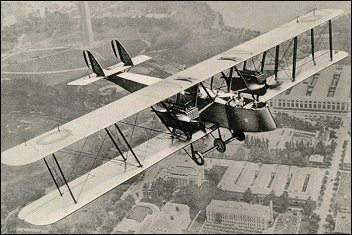 |
Martin MB1918 |  |
| BOMBER, PASSENGER, MAIL | Virtual Aircraft Museum / USA / Martin |
 |
The Glenn L. Martin Company was organised during World War I and produced the first successful twin-engined aeroplane of American design, as the W. F. Night Bomber or "Seven Ton" bomber. As it is generally accepted that the first bomber built for the USAAS was the MB-1 (first flown on 15 April 1918), the view can be taken that the W.F. and MB-1 are one and the same. Contemporary reports state that the W.F. was converted into the passenger and cargo-carrying Commercial type. Again it is known that one of the ten MB-1 was so converted, although a drawing of the Commercial made in 1921 shows a rounded-nose aircraft with folding outer-wing sections, single-wheel landing-gear units and open cockpit for the pilots, while the MB-1-type Commercial was actually produced with an enclosed cockpit. Nevertheless as features of the Commercial were subsequently to be found on the improved MB-2 bombers, including the revised single- instead of double-wheel landing gear units, it can be taken that the W.F. Commercial and MB-1-type Commercial or T-1 were the same aircraft. All but one of the remaining MB-1 were produced as bombers or observation aircraft, followed by four more military MB-1 for US Government air mail services. A further two were produced as torpedo bombers for the US Navy, which designated them MTB-1. As an interim stage between the MB-1 and the later MB-2, Martin produced the MT-1 extended-wing torpedo bomber, eight of which were operated by the US Marine Corps. The MB-2 itself was powered by 313kW instead of 298kW Liberty engines and had the wing span of the MT-1 and the landing gear of the Commercial. One hundred and thirty were produced by four manufacturers, a large number as short-range NBS-1 night bombers. Bombs were carried in racks in a compartment in the fuselage, or, in the case of large bombs, on special racks or chocks directly under the fuselage. Interestingly one MB-2, fitted with super-chargers, attained an altitude of about 8,077m while carrying a pilot and three observers. A contemporary report states that, had it not been for the extreme cold and lack of fuel, a still greater altitude could have been reached. MB/NBS-1 bombers were eventually replaced in service by Keystone types. The MB-2 is best remembered as the aircraft with which Brig-Gen William "Billy" Mitchell demonstrated the effectiveness of the bomber by sinking the stationary ex-German warship Ostfriesland. During the same demonstrations on 21 July 1921, other MB bombers and flying-boats destroyed a submarine, cruiser and destroyer.
|  COMPANY PROFILE | |||||||||||||||||||||||||||||||||||||||||||||||||||||||||
 |

|

